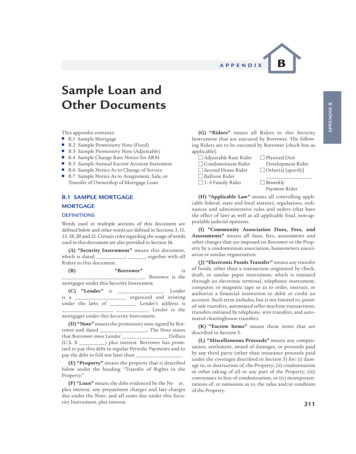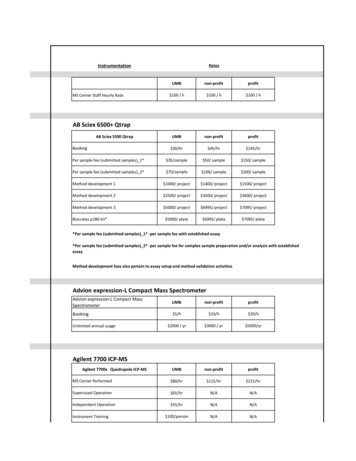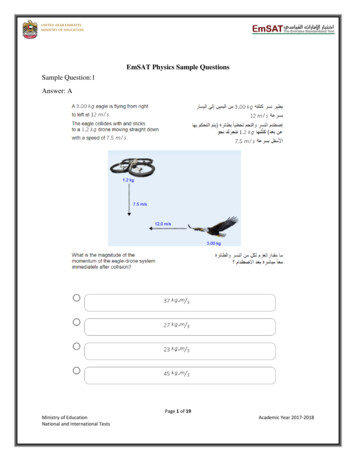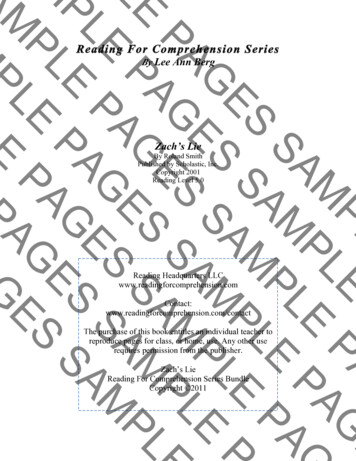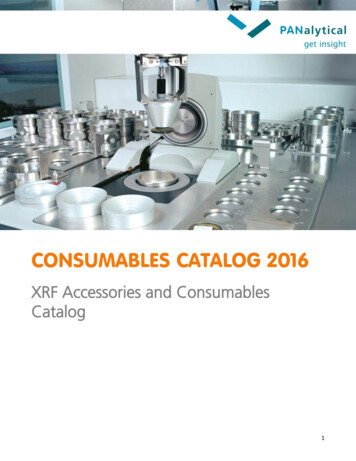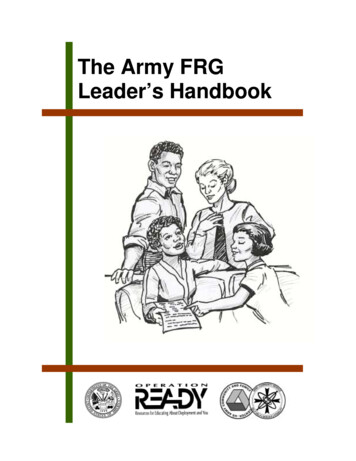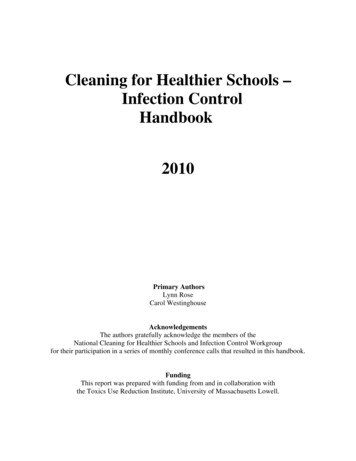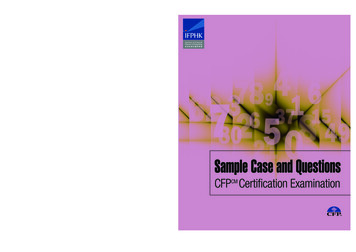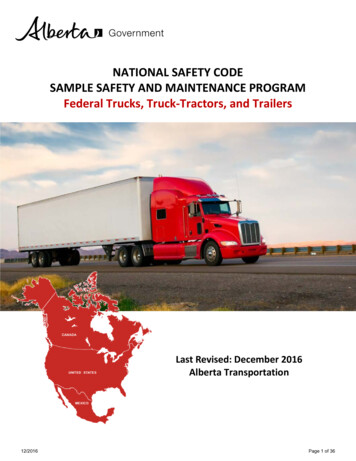
Transcription
NATIONAL SAFETY CODESAMPLE SAFETY AND MAINTENANCE PROGRAMFederal Trucks, Truck-Tractors, and TrailersLast Revised: December 2016Alberta Transportation12/2016Page 1 of 36
NOTICE TO READERSThis document has been prepared by the Carrier Services Section of Alberta Transportation. It includes samplesafety and maintenance programs for federal carriers that operate trucks, truck-tractors, and/or trailers. Federalcarriers operate commercial vehicles registered for a weight of more than 4,500 kilograms outside of Alberta.What are Safety and Maintenance Programs?Safety and maintenance programs are written documents that provide safety and maintenance expectations forall employees within a company. All National Safety Code (NSC) carriers are required by law to have theseprograms in place. The safety program allows carrier safety management to ensure all authorized drivers havesufficient training and qualifications to safely operate the company’s commercial vehicles. The maintenanceprogram helps management confirm that all vehicles owned by the company are properly maintained beforethey are operated on highways. For more information about the purpose of safety and maintenance programs,refer to Modules 5-6 of the Commercial Vehicle Safety Compliance in Alberta education manual.Using these sample Safety and Maintenance ProgramsThis document MUST be altered to address the compliance and operational needs of a specific carrier. Thissample document, by itself, should not be used or accepted as meeting a carrier’s regulatory requirement unlessit has been appropriately modified and implemented.Carriers that use these sample programs to meet regulatory requirements must go through the document andfill in the missing fields. Any attempt to submit the document without the completed fields will result in anerror message when the “Submit” or “Print” button is clicked on the last page. Carriers that wish to includemore policies that are specific to their operations may use these samples as a guideline for ensuring they meetminimum regulatory requirements.Every effort has been made to ensure that the information in this document is accurate at the time ofpreparation. However, this document is intended to serve only as a guide and cannot replace first-handinformation such as specific legislation. The items included in this document are considered to be theminimum items required by law. Carriers may include additional policies to these minimumrequirements in their programs. It is the carrier’s responsibility to ensure that safety and maintenanceprograms meet all regulatory requirements.Corrections, comments and suggestions for this document can be submitted to Alberta Transportation at anytime by contacting Carrier Services Section at 403-755-6111 (toll free in Alberta by first dialing 310-0000) or byemail to compliance.info@gov.ab.ca.To assist you in meeting the minimum requirements, the following website may help when developing yourprograms and/or training. You are required to implement your safety and maintenance program, evaluate itperiodically and update it as necessary. For more information on safety and maintenance programs andtraining, view our education manual online at: www.transportation.alberta.ca/671.htm.12/2016Page 2 of 36
For more information on Regulatory Requirements consult the following legislation: Commercial Vehicle Certificate and Insurance Regulation (AR 314/2002);Commercial Vehicle Safety Regulation (AR 121/2009);Vehicle Inspection Regulation (AR 211/2006);Vehicle Equipment Regulation (AR 122/2009); andTraffic Safety Act.Alberta regulations are available from the Queens Printer at 780-427-4952 or online at: www.qp.alberta.ca12/2016Page 3 of 36
SAFETY PROGRAM FORCOMMERCIAL TRANSPORTATIONFederal Trucks, Truck-Tractors,and TrailersName on Safety Fitness Certificate:Prepared By:12/2016Page 4 of 36
AUTHORIZED DRIVERSAuthorized drivers include all employees that are permitted to operate National Safety Code vehicles registeredto . Authorized drivers include:Company Name managers/owners who drive;part-time or occasional drivers;company mechanics who test drive vehicles or drive part-time;safety staff who train drivers;lease operators who have their vehicles registered to the company;contractors who have their vehicles registered to the company;anyone else authorized to operate a company vehicle.All authorized drivers must follow the policies and procedures found in this safety program. By following thepolicies in this program, all authorized drivers will be more aware of how to operate safely and to preventcollisions.12/2016Page 5 of 36
PART 1: SAFE USE AND OPERATION OF VEHICLESwill ensure all drivers are aware of the safe use and operation of commercialCompany Namevehicles. Drivers must comply with all transportation safety laws, including those related to:Speed LimitsDrivers must obey all posted speed limits and reduce speed according to road, weather, visibility conditions andvehicle type.Seat Belt UseAll authorized drivers, while operating or travelling as a passenger in company vehicles, must wear seat belt(s) atall times.Drug and Alcohol UseThe possession and/or consumption of alcohol, illegal drugs, or the misuse of prescription drugs are strictlyprohibited while drivers operate company vehicles and other equipment.Defensive DrivingAuthorized drivers must operate company vehicles in a professional and courteous manner. Drivers must beprepared to avoid collision causing situations by practicing and by promoting the principles of defensive driving.For example, drivers must be aware of their surroundings and look ahead. Drivers should leave a safe distancebetween vehicles, keep the vehicle under control at all times and be prepared for changes in road, weather andtraffic conditions.Distracted DrivingAs part of practicing the principles of defensive driving, authorized drivers must remain focused and follow alldistracted driving laws. The following activities conducted while driving are considered distracted driving: 12/2016using hand-held cell phones;texting or emailing (even when stopped at red lights);using electronic devices like laptop computers, video games, cameras, video entertainment displays, andprogramming portable audio players (e.g. MP3 players);entering information on GPS units;reading printed materials in the vehicle;writing, printing or sketching; andpersonal grooming (brushing teeth, putting on makeup, clipping nails, shaving, etc.).Page 6 of 36
Cargo SecurementThe carrier and driver must ensure that all any cargo transported is contained, immobilized or secured inaccording to National Safety Code Standard 10. The following are some general guidelines for ensuring cargo issecured in a safe manner. Generally, cargo transported on a commercial vehicle must not: leak, spill, blow off, fall from, fall through or otherwise dislodge from the commercial vehicle; orshift upon or within the commercial vehicle to such an extent that the commercial vehicle’s stabilityor maneuverability is adversely affected.Drivers must inspect the cargo and its securing devices within the first 80 kilometres after beginning a trip.Drivers must re-inspect cargo when any one of the following occurs: change of duty status (e.g. from “driving" to “on-duty not driving”);after driving for 3 hours; orafter driving 240 kilometres.An employee or driver will not use any vehicle to transport goods unless; the vehicle is constructed to carry the goods, andthere is equipment on the vehicle or attached to the vehicle that is capable of securing the goods toensure the vehicle can be operated safely when loaded without danger of turning over the vehicle orthe load shifting, swaying, blowing off, falling off, leaking or otherwise escaping.Drivers are not permitted to transport any cargo unless it is properly secured. For more detailed information,refer to the company cargo securement training program.FuellingBefore fuelling, the driver must: 12/2016shut off engine;not smoke;check for fuel leaks;not overfill the tank;not leave nozzle unattended; andreplace filler cap when finished fuelling.Page 7 of 36
PART 2: PROPER RECORD COMPLETIONwill train staff in hours of service records, bill of lading/manifests, dangerousCompany Namegoods records, weigh slips, and other documents that are required to be completed by law. A record will bemaintained on each driver’s file showing that the employee has this knowledge or any training received. Thecompany will evaluate each type of record for proper completion.1. Hours of Service RecordsRefer to the following resources for more information on federal hours of service requirements:Commercial Vehicle Drivers Hours of Service Regulations (SOR/2005-313)Reference Guide for Hours of Service Training DevelopmentModule 7 of the Commercial Vehicle Safety Compliance in Alberta manualDaily Log CompletionUnless exempted by law, all authorized drivers must complete daily logs for every calendar day they areemployed by the company. The following information provides a brief summary for what must be included in adaily log:At the beginning of each day: the start time of day if different than midnight, the name of the driver and, if the driver is a member of ateam of drivers, the names of the co-drivers;in the case of a driver who is not driving under the provisions of an oil well service permit, the cycle thatthe driver is following;the commercial vehicle licence plates or unit numbers;the odometer reading of each of the commercial vehicles operated by the driver;the names and the addresses of the home terminal and the principal place of business of every motorcarrier by whom the driver was employed or otherwise engaged during that day;in the “Remarks” section of the daily log, if the motor carrier or driver was not required to keep a dailylog immediately before the beginning of the day, the number of hours of off-duty time and on-duty timethat were accumulated by the driver each day during the 14 days immediately before the beginning ofthe day; andif applicable, a declaration in the “Remarks” section of the daily log that states that the driver isdeferring off-duty time under section 16 and that clearly indicates whether the driver is driving underday one or day two of that time.During the course of the day: 12/2016the hours in each duty status during the day covered by the daily log, in accordance with Schedule 2,and the location of the driver each time their duty status changes, as that information becomes known.Page 8 of 36
At the end of each day: the total hours for each duty status and the total distance driven by the driver that day, excluding thedistance driven in respect of the driver’s personal use of the vehicle, as well as the odometer reading atthe end of the day and sign the daily log attesting to the accuracy of the information recorded in it.Electronic Daily LogsElectronic daily logs generated by Electronic Logging Devices (ELDs) may be submitted as long as they containthe same information in the same format that is required by regulation for a handwritten daily log. Failing toproduce an electronic daily log will be treated the same as failing to produce a daily log in handwritten format.This includes if the electronic daily log data is: illegible;inoperable due to driver error;inoperable due to device malfunction, orunavailable for any other reason.For more information, refer to the Electronic Log Policy: www.transportation.alberta.ca/5610.htmRetention and Distribution of Log BooksDrivers must forward the original copy of their daily log and supporting documents to their home terminalwithin 20 days of the completion of the daily log.Within 30 days of receiving the daily logs and supporting documents, the company will deposit these records atthe principal place of business and retain all daily logs and supporting documents in chronological order for eachdriver for at least 6 months.Hours of service records will be maintained at the following location:Physical Address in Alberta (must be the same as the company’s principle place of business):Time Records for Drivers Operating within 160 kilometers of the Home TerminalAuthorized drivers are not required to maintain a daily log where ALL of the following conditions are met: 12/2016Driver/vehicle does not operate beyond 160 kilometers radius of the home terminal;Driver returns to home terminal each day to begin a minimum of 8 consecutive hours of off-duty time;Page 9 of 36
The company maintains and retains for a period of 6 months accurate and legible records showing, foreach day the driver’s duty status and elected cycle, the hour at which each duty status begins andends and the total number of hours spent in each status;The driver is not driving under a permit issued under the Commercial Vehicle Drivers’ Hours of ServiceRegulation.When a driver was not required to keep a daily log before the beginning of the day (radius operation), the drivershall in the “remarks” section of the daily log record the number of hours of off-duty time and on-duty time thatwas accumulated by the driver for each day during the 14 days immediately before the beginning of the day.2. Shipping DocumentsBills of LadingWhere applicable, a Bill of Lading shall be identified by a numerical code or other means of identification andshall set out at least the following: name and mailing address of the consignor;date of the consignment;point of origin of the shipment;name of the originating carrier;names of connecting carriers, if any;name and mailing address of the consignee;destination of the shipment;particulars of the goods comprising the shipment, including weight and description;a space for the signature of the consignor or his agent;a provision stipulating whether the goods are received in apparent good order and condition;a space in which to show the declared value of the shipment;where charges are to be prepaid or collected;a space in which to indicate whether the charges are prepaid or collect;a space in which to show whether the C.O.D. fee is prepaid or collect;a space in which to show the amount to be collected by the carrier on a C.O.D. shipment;a space in which to note any special agreement between the consignor and the carrier;a statement in conspicuous form indicating that the carrier’s liability is limited by a term or condition ofthe applicable schedule of rates or by other agreement, if such a limitation exists.The person who is the originating carrier of the goods being shipped shall, on the bill of lading issued for thosegoods: 12/2016acknowledge receipt of the goods by signing the bill of lading, andindicate the condition of the goods and give details of any defect.Page 10 of 36
WaybillsInstead of carrying a bill of lading for the goods transported, the company may carry a waybill for the goodsissued by the consignor or carrier. A waybill shall be identified by the numerical code or other means ofidentification set out on the bill of lading and set forth at least the following: particulars of the goods carried on the vehicle;name and mailing address of the consignor;point of origin of the shipment;name and mailing address of the consignee;destination of the shipment;names of connecting carriers, if any;whether the charges are prepaid or collect;date of the consignment.Note: See Section 2 of the Bill Of Lading and Conditions of Carriage Regulation (AR 313/2002) for exemptions(e.g. owner’s own goods).Dangerous Goods Shipping DocumentsIf the company transports Dangerous Goods, a Dangerous Goods Shipping Document shall contain, at minimum,the following information: Consignor’s name and address in Canada;Date of shipment;Description of the goods: (in the following order)1. UN number (e.g. UN1230);2. Dangerous goods shipping name (e.g. Methanol);3. Primary class and subsidiary class (e.g. 3(6.1));4. If applicable, the packing group in roman numerals (e.g. I, II or III) or the compatibility groupletter for explosives;5. If applicable, the words "toxic by inhalation" or "toxic – inhalation hazard" for dangerous goodssubject to Special Provision 23 (Class 6.1, PGI, toxic due to inhalation);The quantity in metric measurement (e.g. kg or L) for transport originating in Canada;The “24-hour number” of a person who can provide technical information on the dangerous goods; andThe consignor’s certification.In some cases, more information may need to be included, such as: 12/2016The number of small means of containment (e.g. volume of 450 L or less) that require labels;The technical name or the statement “not odorized”;The Emergency Response Assistance Plan (ERAP) number and its activating telephone number; Note: AnERAP is only required for certain dangerous goods in certain quantities. To learn more about ERAP,please consult Part 7 of the TDG Regulations.Page 11 of 36
The flash point, if the product is a Class 3 flammable liquid and is being transported on a ship; (e.g.gasoline, diesel, etc.);Special instructions, such as the control and emergency control temperatures of Classes 4.1 and 5.2; andThe number of any applicable Transport Canada Equivalency Certificates.Shipping documents must be carried within the driver’s reach and, when the driver leaves the cab, the shippingdocuments must be left on the driver’s seat, in a pocket on the driver’s door or in an obvious place in the cab. Ifthe vehicle is left in a supervised area, a copy of the shipping document must be left with the person in charge.Note: There may be exemptions to regulations. Refer to Part 3 of the Transportation of Dangerous GoodsRegulations (SOR/2001–286).For more information refer to the web site: www.transportation.alberta.ca and/or contact the Dangerous GoodsCoordination and Information Centre at 800-272-9600 for further information on bulletins, permitting andgeneral information.Weigh SlipsThe company will obtain accurate vehicle weights and weigh slips for vehicles that are required to be weighedunder the Bill Of Lading and Conditions of Carriage Regulation (AR 313/2002).12/2016Page 12 of 36
Safety LawsPART 3: COMPLIANCE WITH THE LAWDrivers operating vehicles owned by will comply with all transportation safetyCompany Namelaws as required. The Commercial Vehicle Certificate and Insurance Regulation (AR 314/2002) identifies that:“safety laws” means, as the context requires,i)ii)iii)the Act (Traffic Safety Act) and regulations made under the Act;the Dangerous Goods Transportation and Handling Act and the regulations made under that Act;the laws of a jurisdiction outside Alberta, respecting the same, similar or equivalent subjects as thoseregulated or controlled by the laws referred to in sub clauses (i) and (ii).Safe VehiclesVehicle Condition:Drivers will not operate and the company will not permit a person to operate a commercial vehicle if the vehicleor any equipment related to the commercial vehicle is in a condition likely to cause danger to persons orproperty.12/2016Page 13 of 36
PART 4: USE OF SAFETY EQUIPMENTUse of Warning DevicesDuring the night time a commercial vehicle will not be stationary on a highway outside the limits of an urbanarea unless; the hazard lights are alight if functional; andadvanced warning triangles are placed without delay on the highway in line with the commercial vehicleat a distance of approximately 30 metres behind and in front of the commercial vehicle.When there is insufficient light or conditions where objects are not clearly discernable at 150 metres,commercial vehicles will not be stationary outside of the limits of an urban area unless; the hazard lights are alight if functional, andadvanced warning triangles are placed without delay on the highway in line with the commercial vehicleat a distance of approximately 75 metres behind and in front of the commercial vehicle.During the day time a person will not permit a commercial vehicle to be stationary on a highway outside thelimits of an urban area unless; the hazard lights are alight if functional, andadvanced warning triangles are placed without delay on the highway in line with the commercial vehicleat a distance of approximately 75 metres behind and in front of the commercial vehicle.Warning triangles and hazard lights are used to make other traffic aware of parked commercial vehicles.Use of Fire ExtinguishersIf the need to use a fire extinguisher arises:Remember the word PASS Pull - Pull the safety pin by breaking the seal;Aim – Aim the nozzle, horn or hose at the base of the fire;Squeeze - Squeeze the handle;Sweep – Sweep from side to side moving carefully toward the fire keep the extinguisher aimed at thebase of the flame and sweep back and forth until the flames appear to be out.Safety instructions: 12/2016remove the fire extinguisher from its bracket;approach the fire from upwind if possible;Page 14 of 36
hold the extinguisher in an upright position;continue to use until the fire is out and the fire extinguisher is empty;replace the safety pin and return it to your compartment;have extinguisher recharged immediately or replaced before your next run;report use of fire extinguisher to supervisor.Use of Personal Protective Equipment (PPE)will ensure all employees are educated on the proper use of all issued PPE (e.g.Company Namegoggles, hard hats, breathing apparatus, etc.). Any education or training will be documented and placed on thedriver’s file.Note: Reference Occupational Health and Safety Act for specific instructions and the use of PPE. Thislegislation may also require additional components to be covered in the safety program. The OccupationalHealth and Safety Act is available online at: 307.html.12/2016Page 15 of 36
PART 5: DRIVER CONDUCT AND DISCIPLINEDriver ConductDrivers must practice good conduct by keeping the following policies in mind: safely operate company vehicles on the highway with a professional attitude and obey posted speedlimits;drive in a defensive manner, be aware of surroundings and look ahead. Leave a safe distance betweenvehicles and be a professional and courteous driver;keep the vehicle under control at all times and reduce speed due to changes in road, weather and trafficconditions;be prepared to avoid collision producing situations by practicing and promoting safe driving skills;report all significant events on road to the company safety officer, including violations, near misses, etc.Disciplinary Procedures (STEPS)All disciplinary steps taken by will be progressive in nature. All actions taken,Company Nameincluding verbal warnings, will be documented. Disciplinary action may be taken with employees for any: regulatory violations (identified on the Carrier Profile, driver’s abstract or through internalevaluations/audits).significant company policy violations (identified through internal audits, direct observation, reports fromother staff, and reports from the public/customers).As appropriate, disciplinary action may include: written warnings;suspension; ortermination.The disciplinary process may also require corrective measures, such as re-training. For severe violations thatpose a significant risk to public safety, the company may take disciplinary action at any stage based on theseverity of the violation.Where any form of disciplinary action is taken against a driver, this action must be documented and recorded inthe driver’s file.12/2016Page 16 of 36
PART 6: DRIVER QUALIFICATIONSDriver QualificationsWhen hiring new drivers, will ensure the driver is qualified for the job byCompany Namereviewing their driver abstract. By reviewing the commercial driver abstract, the company will ensure the driverhas a valid operator’s licence for the class of vehicle they will be operating. The company will also examine thedriver’s history to determine whether they are qualified to operate a commercial vehicle safely.When hiring new drivers, the company may also: conduct a personal interview to evaluate attitude, driving skills and professionalism;contact references and past employers;conduct a road test to include: use of two and four lane highways, city driving, and yard backing andparking, shifting, turning, mirror usage, speed and general awareness;evaluate the skills and knowledge of a driver by conducting a written exam;address any special training requirements (e.g. dangerous goods, long combination vehicle, etc.);implement a maximum abstract point threshold (e.g. specify maximum demerit points allowed within athree year period and do not hire if exceeded);implement a maximum collision threshold (e.g. consider if your threshold will include preventablecollisions only or all collisions. Do not hire the applicant if the threshold is exceeded);implement a policy addressing procedures for suspended licence.implement a policy requiring drivers to immediately report changes of their Driver's Licence status totheir employer (for example, suspensions or medical requirements/conditions).Driver EvaluationsThe company will perform written driver evaluations according to the intervals in the chart below:Driver EvaluationTypeEvaluation IntervalNew HireEvaluate on hireProbationary DriverNon-compliant DriverNormal Driver12/2016CommentsComplete written driver evaluationform and place on driver file.Complete written driver evaluationform and ensure driver has correctedany issues identified in evaluationconducted at hire.Complete written driver evaluationsuntil satisfied the driver understandsand can comply with requirements.Complete written driver evaluationform and place on driver file.Page 17 of 36
Drivers will be evaluated for skills involving: driving in traffic, backing up, connecting a trailer, fuelling, driving inthe mountains, driving defensively, conducting daily Trip Inspections, and identifying and reporting defects tothe carrier. The company maintains an ongoing program for evaluating employees’ driving skills using: road tests (see Evaluation form on the next page);internal audits of records (logbooks, time records, etc.).Drivers may also be required to take written exams to test driver skills and knowledge of (as applicable): hours of service;weights and dimensions;cargo securement;dangerous goods;daily trip inspections;other:Driver Evaluation results will be retained on each driver’s file. A sample driver evaluation form is attached.12/2016Page 18 of 36
DRIVER EVALUATIONCarrier Name:Current Class of Operator’s Licence2341Driver Name:DRIVER ACTIONSDate:Signature of Driver:Performance AssessmentGoodFairPoorA. CONTROLSDRIVER ACTIONS5Date:Performance AssessmentGoodFairPoorE. TRAFFIC LIGHTS / SIGNS1. Knowledge and/or use of equipment1. Fails to anticipate / observe2. One-handed steering – hand position2. Judgment – green / amber / red3. Steering Control – wanders / recovery3. Judgment – stop / yield / other4. Shifts too soon / late / lugsF. RIGHT-OF-WAY5. Improper use of gears / grinds6. Improper use of clutch / stalls/ coasts1. Uncertain / hesitant7. Improper use of brake / park brake2. Fails to assume own right of way8. Improper use of accelerator3. Aggressive / Judgment9. Signals too soon / lateG. SPEED10. Signals – improper / not cancelled/none1. Too fast for conditionsB. PARKING / STARTING / BACKING2. Too slow for conditions1. Fails to set brake / gearH. BACKUP / TURN AROUND2. Observation – backing / starting3. Judgment – vehicle / wheels / angle1. Poor observation – before / during5. Rolls back2. Judgment of distance / position6. Unsure / too slowC. LANE DRIVING / CHANGING / POSITIONI. ROAD TEST DISQUALIFICATION1. Fails to check mirror1. Overall poor performance2. Fails to check blind spot / late2. Right of way violation – vehicle /pedestrian3. Uncertain / hesitant3. Traffic light violation4. Road position – straddles lane4. Stop sign violation5. Too close / far – stop / pass / follow5. Speeding violation6. Improper lane change / late / slow6. Other violation7. Fails to observe signs / conditions7. Climbs over curb8. Lacks caution at uncontrolledintersection9. Obstructs trafficD. INTERSECTIONS / TURNS / RR1. Block crosswalk / intersection / stop line10. Unable to perform skill maneuver2. Stops too far back11. Hits vehicle / object3. Unnecessary stop12. Lacks skill and control4. Fails to leave parking lot13. Unsafe action5. Fails to observe conditions / late14. Trip inspection failure6. Left turn – cuts corner / turns wideJ. GENERAL DRIVER KNOWLEDGE7. Left turn – wrong lane – before / after8. Right turn – cuts corner / turns wide1. Hours of Service9. Right turn – wrong lane – before / after2. Trip Inspections10. Incorrect position – vehicle / wheels3. Cargo Securement11. Too fast – before / during4. Weights and Dimensions12. Too slow – before / duringTEST ADMINSTRATION INFORMATION:Authorized to drive:Yes:Safety Officer’s Name:Signature:12/2016COMMENTS:No:Page 19 of 36
PART 7: DRIVER RECORDS AND RECORD RETENTIONDriver Fileswill keep a driver record for every person authorized to operate companyCompany Namevehicles, including owner(s) and management. These records will include the following information: the driver’s completed application form for employment with the registered owner, where applicable(note: the driver’s resume is considered to be an acceptable application);the driver’s employment history for the three years immediately preceding the time the driver startedworking for the carrier, where applicable;a copy of the driver’s abstract in a form satisfactory to the Registrar when the driver is first hired oremployed, dated within 30 days of the date of employment or hire;annual updated copies of the driver’s abstract in a form satisfactory to the Registrar;a record of the driver’s convictions of safety laws in the current year and in each of
they are operated on highways. For more information about the purpose of safety and maintenance programs, refer to Modules 5 -6 of the . Commercial Vehicle Safety Compliance in Albert. a education manual. Using these sample Safety and Maintenance Programs . This document MUST be altered to address the compliance and operational needs of a .

